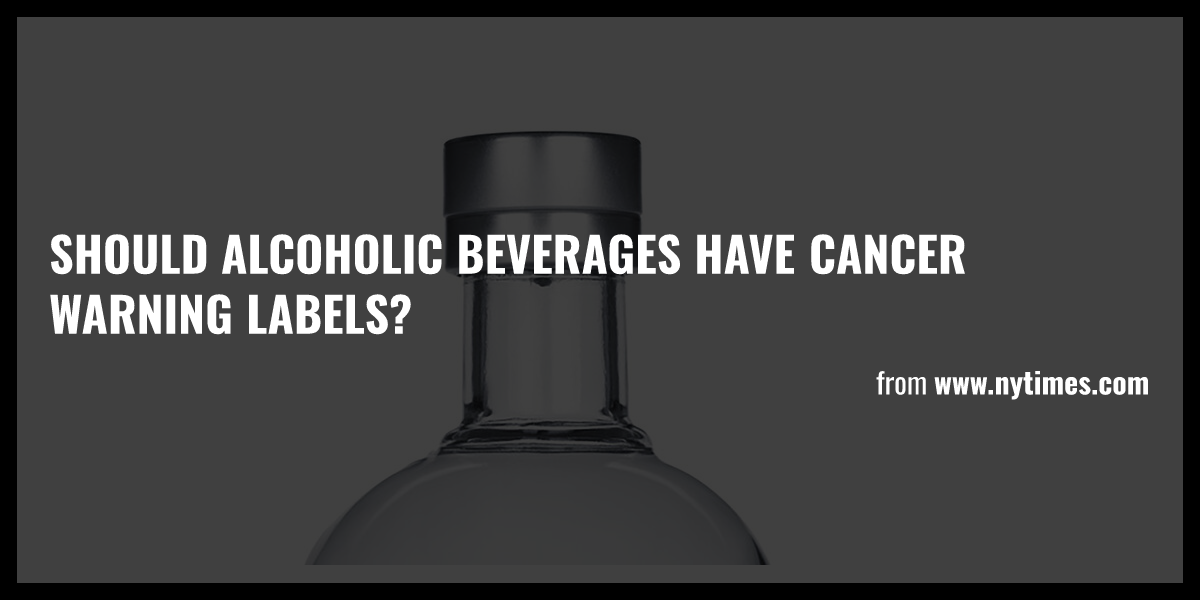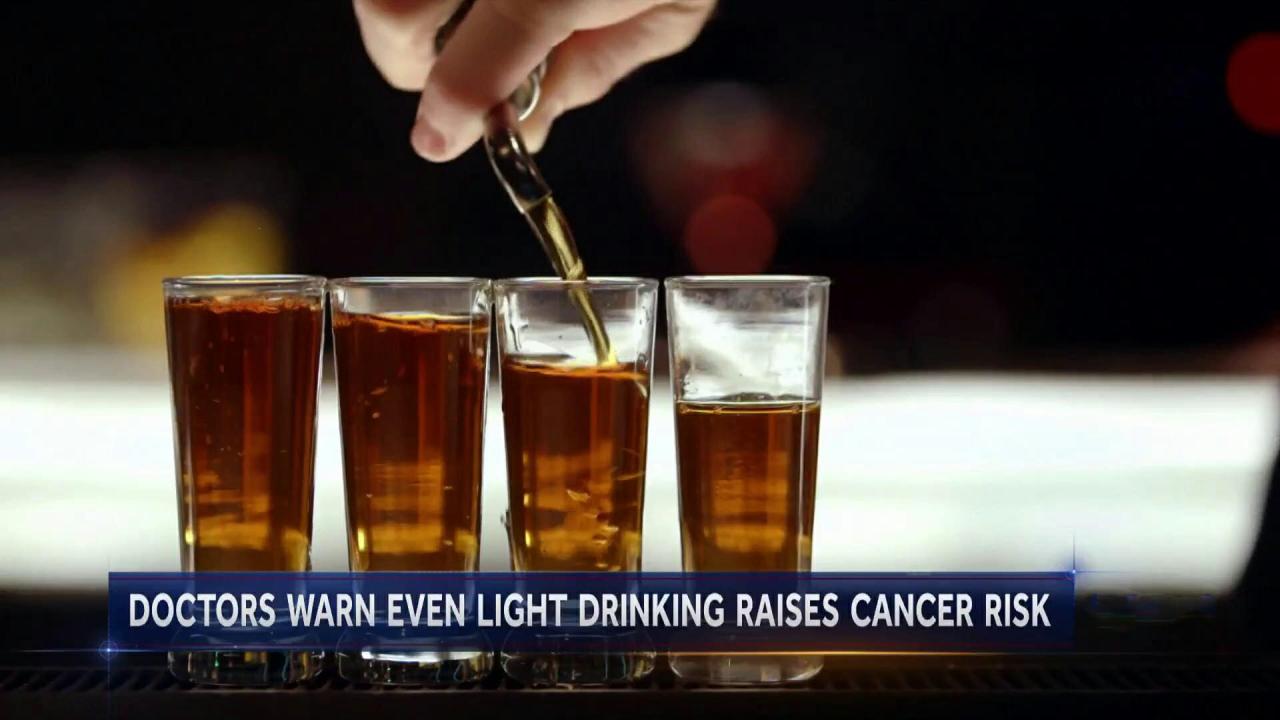Putting a cancer warning on alcohol is overdue, doctors say. For years, the link between alcohol consumption and various cancers has been undeniable, yet alcohol labels remain relatively benign compared to those on tobacco products. This begs the question: why the disparity? This article delves into the public health implications, ethical considerations, and economic factors surrounding the urgent need for stronger, clearer warnings on alcoholic beverages.
We’ll explore the potential impact of such warnings on consumer behavior, examining successful public health campaigns that have influenced choices around risky products. We’ll also analyze the legal and logistical hurdles involved in implementing mandatory warnings, including potential pushback from the alcohol industry. Finally, we’ll consider the role of healthcare professionals in advocating for this crucial change and highlight international best practices.
The Public Health Impact of Alcohol Consumption
Alcohol consumption significantly impacts public health, contributing to a range of diseases and social problems. A crucial aspect of this impact is its link to various cancers, necessitating a comprehensive examination of its correlation, existing public health initiatives, and the potential for improved warning labels.
Alcohol Consumption and Cancer Types
Extensive research demonstrates a strong correlation between alcohol consumption and several cancer types. These include cancers of the mouth, throat, larynx, esophagus, liver, breast, bowel, and more. The risk increases with the amount and frequency of alcohol consumed. The mechanisms through which alcohol contributes to carcinogenesis are complex and involve the interaction of alcohol’s metabolites with DNA, leading to cellular damage and uncontrolled growth.
Existing Public Health Campaigns on Alcohol-Related Risks
Various public health campaigns already exist, aiming to raise awareness about alcohol-related risks. These campaigns often employ different strategies, such as television advertisements, social media initiatives, and educational materials. However, the effectiveness of these campaigns varies considerably, and there’s ongoing debate about optimal strategies for reaching different demographics.
Comparison of Alcohol and Tobacco Warning Labels
Current warning labels on alcohol products are generally less graphic and impactful than those on tobacco products. Tobacco warning labels often feature stark imagery of diseased organs and strong cautionary messages. The contrast highlights a potential area for improvement in alcohol warning label design, moving towards a more impactful and attention-grabbing format.
Proposed New Warning Label Design for Alcohol Products
A new warning label could incorporate a graphic image depicting a diseased organ (e.g., a liver ravaged by cirrhosis), accompanied by a concise and impactful message such as “Alcohol causes cancer.” The design should be visually striking and easily understandable, regardless of the consumer’s literacy level. Consideration should be given to using multiple languages, depending on the target market.
Ethical and Legal Considerations of Mandatory Cancer Warnings
Implementing mandatory cancer warnings on alcohol products raises several ethical and legal considerations. Balancing public health concerns with industry interests and individual freedoms is paramount. The potential for legal challenges from the alcohol industry requires careful consideration of existing regulations and precedents.
Potential Legal Challenges to Implementing Mandatory Warnings
The alcohol industry might challenge mandatory cancer warnings on grounds of free speech, arguing that such warnings constitute an infringement on their commercial expression. Precedents set in tobacco litigation might influence the legal landscape and shape the arguments presented. The specific legal framework of each jurisdiction will play a crucial role in determining the legality and feasibility of implementing such warnings.
Ethical Implications Compared to Other Harmful Products
The ethical implications of warning labels on alcohol are comparable to those on other potentially harmful products like tobacco and sugary drinks. The primary ethical consideration revolves around the balance between individual autonomy and the collective responsibility to protect public health. A consistent approach across various product categories is desirable to maintain ethical coherence.
Arguments For and Against Government Regulation
Arguments in favor of government regulation emphasize the significant public health benefits of reducing alcohol-related cancers and the need for clear, consistent messaging. Arguments against regulation often cite potential economic impacts on the alcohol industry and concerns about government overreach. A cost-benefit analysis is essential to evaluate the overall impact of such regulations.
Potential Lobbying Efforts from the Alcohol Industry
The alcohol industry is likely to engage in significant lobbying efforts to oppose mandatory cancer warnings. These efforts could involve financial contributions to political campaigns, hiring lobbyists to influence policymakers, and disseminating information aimed at downplaying the risks of alcohol consumption. Transparency in lobbying activities is crucial for informed policymaking.
So, doctors are pushing for cancer warnings on alcohol, which is pretty overdue, right? Think about the sheer amount of data involved in tracking alcohol consumption and cancer rates – that’s where a skilled full stack developer could really make a difference, building the systems to manage and analyze all that information. Ultimately, getting this data to the public to support those warnings is crucial.
Consumer Perception and Behavior Regarding Alcohol Warning Labels
The design and messaging of alcohol warning labels can significantly influence consumer perception and purchasing decisions. Understanding how different designs impact consumer behavior is critical for designing effective public health interventions. Research on effective public health campaigns offers valuable insights into designing persuasive and impactful warning labels.
Influence of Warning Label Designs on Consumer Behavior
Studies have shown that graphic warning labels on tobacco products have led to reduced smoking rates. Similar principles can be applied to alcohol warning labels. For example, labels featuring stark imagery of diseased organs and concise, impactful messaging are likely to be more effective than less graphic labels. Testing different label designs through controlled experiments is crucial to optimize their impact.
Examples of Successful Public Health Campaigns
The success of anti-smoking campaigns demonstrates the potential of public health interventions to alter consumer behavior. These campaigns often employ a multi-pronged approach, combining warning labels with educational programs, media campaigns, and policy changes. The strategies used in these campaigns can inform the development of similar interventions for alcohol consumption.
Hypothetical Study Design to Assess the Impact of Cancer Warnings
A randomized controlled trial could compare alcohol consumption patterns in regions with mandatory cancer warnings versus those without. The study would need to collect data on alcohol purchases, self-reported consumption, and incidence of alcohol-related diseases. Statistical analysis would then assess the impact of the warning labels on alcohol consumption and related health outcomes.
Cost-Effectiveness of Implementing Warning Labels
A cost-benefit analysis should compare the costs of implementing mandatory cancer warnings (e.g., label printing, public awareness campaigns) with the potential savings from reduced healthcare costs associated with alcohol-related cancers. This analysis should consider the long-term economic impact of reduced alcohol consumption, including decreased healthcare expenditures and increased productivity.
International Perspectives and Best Practices in Alcohol Warning Labels
Examining international policies on alcohol warning labels provides valuable insights into best practices and the effectiveness of different approaches. Cultural and societal factors play a significant role in the success of such initiatives. A comparative analysis can highlight effective strategies and inform the development of more impactful warning labels.
Comparison of Alcohol Warning Label Policies Across Countries

Countries have adopted varying approaches to alcohol warning labels. Some countries have mandatory graphic warning labels, while others rely on text-based warnings or have no specific regulations. The effectiveness of these different approaches varies depending on cultural contexts and enforcement mechanisms.
Examples of Successful International Campaigns
Several countries have successfully implemented public health campaigns to reduce alcohol-related harm. These campaigns often combine various strategies, including warning labels, taxation policies, and public awareness campaigns. Learning from these successes can help guide the development of more effective interventions.
Cultural and Societal Factors Influencing Effectiveness
Cultural norms and societal attitudes toward alcohol consumption can significantly influence the effectiveness of warning labels. In some cultures, alcohol consumption is more socially acceptable than in others, which can affect the impact of public health messaging. Tailoring warning labels to specific cultural contexts is crucial for maximizing their effectiveness.
Comparison Table of Alcohol Warning Label Regulations, Putting a cancer warning on alcohol is overdue, doctors say
| Country | Label Design | Mandatory Elements | Effectiveness Data (Illustrative) |
|---|---|---|---|
| Canada | Text-based warnings, some provinces exploring graphic warnings | Health risks, pregnancy warnings | Limited data, ongoing research |
| Australia | Graphic warnings, including images of health consequences | Health risks, cancer warnings, pregnancy warnings | Studies show some reduction in alcohol consumption |
| United States | Mostly text-based warnings, variations across states | Health risks, pregnancy warnings | Mixed results, effectiveness debated |
| United Kingdom | Text-based warnings, primarily on unit pricing | Unit pricing information, health risks | Data on effectiveness is limited |
| Thailand | Graphic warnings, including images and text | Health risks, cancer warnings, pregnancy warnings, religious warnings | Shows positive impact in specific demographic groups |
Economic Implications of Implementing Cancer Warnings on Alcohol
Implementing cancer warnings on alcohol products will have economic consequences, affecting both the alcohol industry and healthcare systems. A comprehensive cost-benefit analysis is needed to understand the overall economic impact of such a policy.
Doctors are pushing for cancer warnings on alcohol, and honestly, it’s about time. We need clearer information about the risks, just like we need to know the score of the Habs’ game; check out the recap of the game here: Call of the Wilde: Montreal Canadiens fall to Blackhawks in Chicago. Getting back to the alcohol warnings, it’s crucial for public health to make these risks more transparent.
Potential Economic Consequences for the Alcohol Industry

Mandatory cancer warnings could lead to reduced alcohol sales and potentially impact the profits of alcohol producers and distributors. This could result in job losses within the industry, although the extent of this impact is uncertain and likely to vary depending on consumer response.
Comparison of Economic Costs: Cancer Treatment vs. Warning Labels
The economic costs of treating alcohol-related cancers are substantial. These costs include hospital stays, medical treatments, lost productivity, and long-term care. Comparing these costs with the costs of implementing cancer warnings can provide a clearer picture of the overall economic benefits of such a policy. The potential reduction in healthcare costs associated with reduced alcohol consumption needs to be carefully weighed against the implementation costs.
Hypothetical Cost-Benefit Analysis
A hypothetical cost-benefit analysis could model different scenarios, considering varying levels of reduction in alcohol consumption and associated healthcare costs. The analysis would need to incorporate assumptions about the elasticity of demand for alcohol, the effectiveness of the warning labels in reducing consumption, and the cost of implementing the warnings. The results could inform policy decisions by demonstrating the potential economic benefits of implementing mandatory cancer warnings.
Role of Healthcare Professionals in Advocating for Cancer Warnings
Healthcare professionals play a vital role in advocating for public health initiatives, including the implementation of cancer warnings on alcohol products. Their expertise and credibility are essential in raising awareness and influencing policy decisions.
Role of Doctors and Healthcare Professionals in Advocacy
Doctors and other healthcare professionals can advocate for cancer warnings by engaging in public health campaigns, lobbying policymakers, and educating patients about the risks of alcohol consumption. Their professional standing lends significant weight to their advocacy efforts.
Examples of Successful Advocacy Campaigns
Numerous successful public health advocacy campaigns have been led by healthcare professionals. These campaigns have successfully raised awareness of various health issues and influenced policy changes. Learning from these successful campaigns can inform strategies for advocating for cancer warnings on alcohol.
Effective Communication of Alcohol Risks to Patients
Healthcare professionals can effectively communicate the risks of alcohol consumption to their patients by providing personalized advice based on individual risk factors, using clear and concise language, and providing resources for support and treatment. A proactive and compassionate approach is crucial for effective communication.
Practical Steps for Healthcare Professionals to Support Implementation

- Engage in public awareness campaigns.
- Lobby policymakers at local and national levels.
- Educate patients about the risks of alcohol consumption.
- Support research on the effectiveness of alcohol warning labels.
- Collaborate with public health organizations.
- Advocate for policy changes that support public health.
Summary: Putting A Cancer Warning On Alcohol Is Overdue, Doctors Say

The evidence is clear: stronger cancer warnings on alcohol are not just advisable, they’re essential. While implementing such changes faces challenges, the potential benefits – reduced cancer rates, improved public health, and a more informed populace – significantly outweigh the costs. The time for decisive action is now. Healthcare professionals, policymakers, and concerned citizens must unite to advocate for a future where alcohol labels accurately reflect the significant health risks associated with consumption.
Ignoring this critical issue would be a grave disservice to public health.
FAQ Insights
What types of cancer are linked to alcohol consumption?
So, doctors are pushing for cancer warnings on alcohol – it’s about time, right? Meanwhile, in completely unrelated news, check out how Burnley’s planning to replace their striker after Barnes left; you can read all about it here: Thorup outlines City striker plans after Ashley Barnes exit. Getting back to the alcohol warnings, it’s a crucial step in public health, helping people make informed choices.
Alcohol is linked to several cancers, including breast, liver, colorectal, and mouth cancers.
How effective are current alcohol warning labels?
Current labels are generally considered ineffective due to their lack of strong visual cues and clear messaging about cancer risk.
What are the potential economic impacts of adding cancer warnings?
While there might be short-term economic impacts on the alcohol industry, the long-term savings from reduced healthcare costs related to alcohol-induced cancers would likely outweigh these.
What is the role of the alcohol industry in this debate?
The alcohol industry often lobbies against stricter regulations, citing potential economic losses. However, the industry’s responsibility in promoting public health should be considered.
